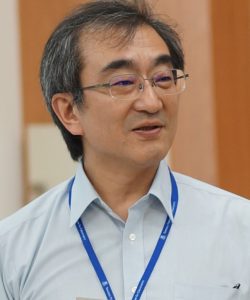
ページ読込中...

ページ読込中...

[English]
| 小池 茂昭 [教授] |  |
|
 |
||
| homepage | https://skoike.w.waseda.jp | |
| 専門分野 | 応用解析、完全非線型偏微分方程式 | |
| 研究テーマ・研究活動 | ||
| 粘性解・正則性理論・自由境界問題・動的計画原理1981年 早稲田大学理工学部物理学科卒業 1988年 早稲田大学理工学部・助手 1989年 東京都立大学理学部・助手 1989年 理学博士(早稲田大学) 1992年 埼玉大学理学部・助教授 2002年 埼玉大学理学部・教授 2010年 日本数学会 JMSJ論文賞 2012年 東北大学理学部・教授 2016年 日本数学会 解析学賞 2019年 早稲田大学理工学術院・教授 |
||
物理学や生物学・化学に現れる多くの自然現象は偏微分方程式として記述され、数学の大きな分野として研究されています。より現実に即したモデルを扱うため、近年、様々な非線型偏微分方程式の研究が盛んに行われています。ほとんどの場合に、偏微分方程式の解を「求める」ことはできません。そこで、解の候補「弱い意味での解」(弱解と呼ぶ)をまず求め、それが「本当の意味での解」になることを示すという2段階に研究を分けています。(後半の部分は、正則性理論と呼ばれることがあります。)自然科学に現れる偏微分方程式の弱解は、シュワルツの超関数が適切です。これは、簡単に言うと「部分積分」を通して得られる弱解です。
一方、工学や最適制御理論など、動的計画原理を通して表現される方程式は完全非線型と呼ばれるもので、方程式が部分積分に適さないタイプです。実は、部分積分が適さない非線型偏微分方程式は幾何学にもしばしば現れます。それら、完全非線型方程式のうち「楕円型」と呼ばれる順序保存型の方程式に対し、別のタイプの弱解(粘性解と言います)がクランダールとリオンスにより1980年初頭に導入され、以降、理論と応用の両面で発展してきました。粘性解は、最大値原理「関数が最大値をとる点では、二回微分は正ではない(非負である)」を通して得られた弱解の概念です。
部分積分も最大値原理も、高校生でも知ってる事実が数学に大きな改革を起こしたわけです。
現在の私の興味の中心は、粘性解の正則性理論です。これは、易しくない理論ですが、
小池研究室に来る学生の多くは、柔軟な頭脳で研究を進めています。
| Shigeaki Koike [Professor] |  |
|
 |
||
| homepage | https://skoike.w.waseda.jp | |
| research field | Applied Analysis, Fully Nonlinear PDEs | |
| research keywords・career | ||
| Viscosity Solutions・Regularity Theory・Free Boundary Problems・Dynamic Programming Principle1988 Research Associate (Waseda University) 1989 Research Associate (Tokyo Metropolitan University) 1989 Phd (Waseda University) 1992 Associate Professor (Saitama University) 2002 Professor (Saitama University) 2010 JMSJ Outstanding Paper Prize 2012 Professor (Tohoku University) 2016 Analysis Prize 2019 Professor (Waseda University) |
||
Various phenomena arising in physics, biology, chemistry can be described by PDEs (partial differential equations), which have been studied as a big research area of mathematics. To consider more realistic models, we are forced to work in nonlinear PDEs.
In research of PDEs, it is almost impossible to obtain solutions expressed by concrete functions. Instead, we first look for a candidate of solutions (solutions in a weak sense) called “weak solutions”, then we try to show that it is a true solution. The second part is called regularity theory which is a never-ending story in PDE theory. For PDEs from natural sciences, weak solutions are considered in the distribution sense developed by L. Schwartz in 1940s. Roughly speaking, the notion of weak solutions in the distribution sense is defined via the integration by parts.
On the other hand, to deal with PDEs arising in Engineerings/Optimal Control Theory via Dynamic Programming Principle, we cannot integrate them by parts. Such PDEs are categorized in fully nonlinear type. In fact, such PDEs also appear in the field of geometry in mathematics.
To study fully nonlinear elliptic/parabolic PDEs, Crandall and Lions introduced a new notion of weak solutions called “viscosity solutions” in early 1980. Afterwards, huge amount of research of its theory and various applications such as game theory, mathematical finance, curvature flows etc. have been done by many mathematicians. The notion of viscosity solutions is derived through the maximum principle: “If a function attains its maximum at a point, then the second derivative cannot be positive”
It is surprising to know that two big inventions come from easy facts which even high-school students understand.
My recent interests are mainly the regularity theory of viscosity solutions, which is far from an easy task but many of my students work around this field with flexible brains.